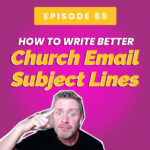Email is not dead. It remains one of the best communication tools available to your church. But for your church emails to be effective, people need to read the emails. And if we want people to read our emails, we need to master the art of writing great subject lines.
In today’s episode, we unpack some of the tips and tricks we have learned to help you write subject lines that will get opened. We’ll cover all the reasons you should be using email for your church communication and all the things you can do to improve your email’s subject lines.
Ready to learn more? Let’s jump into it.
Estimated reading time: 9 minutes
Table of contents
Writing Church Emails

In today’s digital age, emails are a powerful tool for connecting with your church community. Crafting compelling emails can strengthen bonds within your church family and keep members informed and engaged. Here are some simple tips to help you write impactful church emails that resonate with your audience.
Why Email?
Email is a vital tool for churches to communicate with their congregation for several reasons. Firstly, it’s accessible to everyone with an email address, regardless of their location or device. Unlike social media platforms that rely on algorithms, emails land directly in recipients’ inboxes, ensuring they don’t miss important announcements or updates.
Secondly, email clients offer features like scheduling and segmentation. This allows churches to send targeted messages to specific groups within their congregation, such as volunteers or youth members. This ensures that the right information reaches the right people at the right time.
Moreover, email enables churches to maintain consistent communication with their whole church, fostering a sense of unity and community. Whether it’s sharing weekly sermons, upcoming events, or prayer requests, email keeps everyone connected and engaged, even when they can’t physically attend services.
Overall, email is an efficient and effective way for churches to nurture relationships, provide support, and keep their congregation informed and involved.
Clear and Concise Content
Once your church family opens your email, they should immediately understand its purpose and what action, if any, they need to take. Keep your content clear, concise, and relevant. Avoid overwhelming recipients with too much information or lengthy paragraphs.
Use bullet points or numbered lists to break up text and make important information easily digestible. Include relevant links to your church website, online giving platform, or registration forms, making it convenient for recipients to take action.
For example:
- Highlight upcoming events and include a brief description with date, time, and location details.
- Provide links to recent sermons or blog posts for those who want to dive deeper into spiritual content.
- Include a call-to-action button inviting recipients to RSVP for an event, donate, or sign up for a volunteer opportunity.
Remember to maintain a friendly and welcoming tone throughout your email. Your church family should feel valued and encouraged by your communication.
Engage and Encourage Interaction
Encourage interaction and feedback from your church community by inviting them to respond to your emails or participate in discussions on social media. Pose questions, share inspiring stories, or ask for prayer requests to foster a sense of belonging and connection.
Include social media buttons or shareable content to make it easy for recipients to spread the word about upcoming events or meaningful messages. Acknowledge and respond to feedback promptly to demonstrate that you value and appreciate the input of your church family.
By following these simple guidelines and regularly evaluating your email performance, you can effectively communicate with your church community, strengthen relationships, and foster a sense of belonging and engagement within your church family.
8 Tips For Writing Email Subject Lines

So it’s clear: your church should write some solid emails. Now it’s time to jump into one of the most important aspects of emails: writing effective subject lines. Writing great emails is all well and good, but if no one opens them anyway, it all goes to waste. The email subject line might very well be the most important aspect of the email. It’s purpose is to pique interest and lead someone to click on the email.
Let’s explore our top 8 tips for writing awesome email subject lines.
1. Keep It Short
Short subject lines perform better than long ones. If your subject lines are long and drawn out, people will assume the body of your email will be even worse.
There is no right number of words for a subject line, but as a general rule, the fewer, the better. Keep in mind that most phones will only allow for about 30 characters in a subject line, so that number is a good rule of thumb.
2. Personalize It
Most email platforms, like Mailchimp or Constant Contact, allow you to use the recipient’s name in the subject line of your email.
This is a great practice. Whenever we can include personalization, we see an uptick in open rates.
But be sure your database is clean. If the recipient’s name is misspelled there, it will be misspelled in their subject line. That is a great way to get people to unsubscribe.
Also, you want people to know your emails are from… you know, you. If you can make it clear that the email is from your church (in the name of your church email, subject line, first line, etc.), people are more likely to click on it and not brush it off as spam. So do your best to include your church name if possible.
3. Build Urgency
When possible, give your subject lines expiration dates. Ensure that the recipient knows that time is of the essence, and they need to open the email right away.
Terms like “Last Chance to…” or “Registration Closes at Midnight,” will increase your open rate and help more people see your emails.
4. Make It About Them

One of the biggest mistakes we see church communicators make is forgetting who their content is for.
When we write subject lines, we need to remember that people are more likely to read on if the content is something that will be about them.
Instead of talking about all the great things happening at your church, we should be talking about all the ways your recipient will benefit from the great things happening at church. There’s a big difference.
5. Don’t Give Away The Content
The subject line should whet people’s appetite, not fill them up. If you have a big announcement, don’t tell people the meat of it in your subject line. Use the subject to let them know that the information is contained in the email. This makes it so that recipients have to open the email, thus increasing your open rate.
For example, if you just hired a new worship pastor, don’t use the subject line: Meet John, Our new Worship Pastor. Instead, try something like: Our New Worship Pastor is…
We bet that you will see a much higher open rate on the second one.
6. Use an Emoji or Two
Emojis aren’t for everyone, but they are everywhere. While your church needs to appear professional, an emoji used strategically is a great way to get your emails opened.
Please don’t overdo it. Nine emojis are too many for a subject line, but one or two about the theme of the email makes sense.
7. Don’t Forget About the First Line
When crafting emails, don’t overlook the importance of the first line. Your subject line is most important, but if it’s short enough, the email will also show the starting few words of your first line. People will see the first line almost as much as they see the subject line, so it should be considered just as important.
One thing to keep in mind is that your first line should not be a repeat of the subject line. It’s a chance to get across more information to get people to click on the email. If an email in someone’s inbox shows both the subject line and the beginning of the first line, their repetition helps no one. Use it as an extra place to hook the reader.
Keep it short and sweet, but make sure it entices your audience to delve deeper into your message. By giving careful attention to your first line, you can increase engagement and ensure your emails resonate with your audience.
8. Analyze and Adjust
After sending out your church emails, it’s important to analyze and adjust based on the response you receive. Pay attention to metrics like click through rates, which show how many recipients are engaging with your content. If certain subject lines or content formats are generating higher click-through rates, replicate those strategies in future emails.
Likewise, if you notice low engagement, experiment with different approaches to see what resonates best with your congregation. Don’t be afraid to tweak your email strategy based on feedback and data. By continually analyzing and adjusting your approach, you can ensure that your church emails effectively reach and engage your audience.
Church Email Subject Lines

In conclusion, effective communication through email is crucial for churches to connect with their congregation. By crafting attention-grabbing subject lines, keeping content clear and concise, and encouraging interaction, churches can strengthen relationships and foster a sense of community among their members.
Don’t forget to analyze metrics like click-through rates and adjust your email strategy accordingly to ensure maximum engagement. With consistent and thoughtful communication, churches can keep their congregation informed, involved, and inspired, whether they’re gathering in person or connecting online. By prioritizing communication and staying connected, churches can continue to nurture spiritual growth and support their members through all seasons of life.
We pray for success for you and your church! God bless!
More Resources on Email Marketing





